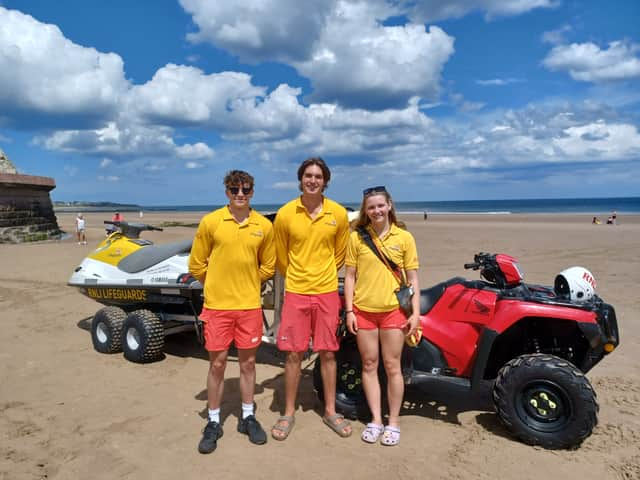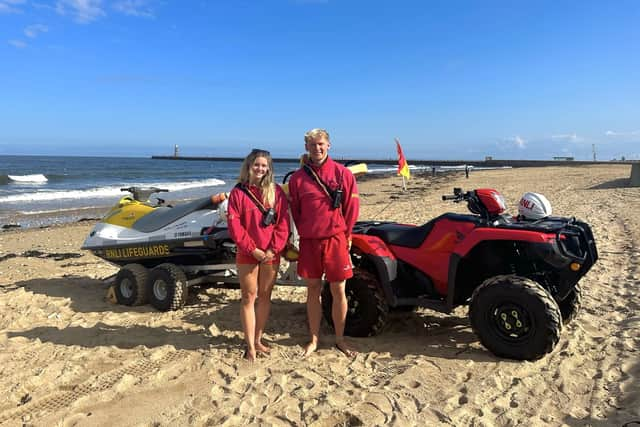Sunderland RNLI lifeguards rescue men after jet ski capsizes off Seaburn Beach
and live on Freeview channel 276
Sunderland lifeguards have been praised for their work in rescuing two men on a capsized jet ski .
RNLI lifeguards Sam Irwin and Ben Mcmann sprung into action when the men got into difficulty 500m out to sea off Seaburn Beach.
Advertisement
Hide AdAdvertisement
Hide Ad

Sam and Ben, who were on patrol at Seaburn, contacted Roker Beach RNLI lifeguards Chris Trotter and Abby Cass for back-up and paddled out to the casualties using their rescue boards.
Sam said: "The two men were knocked off the jet ski into the water. When they had tried to climb back onto it, the jet ski flipped over and became capsized.
"The casualties had no lifejackets or wetsuits on."
Chris and Abby launched from Roker Beach on an RNLI rescue watercraft to assist the incident. When they arrived Sam and Ben had the two men on their rescue boards out of the water.
Chris said: "We assessed the casualties on scene and while both were alert, one of the casualties displayed early signs of hypothermia."
Advertisement
Hide AdAdvertisement
Hide AdThe casualty, who the RNLI said appeared to be suffering with symptoms of hypothermia, was moved by the charity’s lifeguards onto the sledge at the back of the rescue watercraft.


Chris and Abby aided the first man back to Seaburn shore where RNLI Senior Lifeguard Joe Wilson was waiting with the first-aid responder bag to treat them.
In the meantime, Seaburn lifeguards Sam and Ben continued to stay with the second casualty on one of their rescue boards until the rescue watercraft could return and also safely help them back to the beach.
Due to the strong currents that day, the capsized jet ski started to sink.
Advertisement
Hide AdAdvertisement
Hide AdChris and Abby remained nearby on the rescue watercraft to make sure the jet ski did not hit or crash into any close by rocks while the lifeguards at Seaburn contacted Sunderland Lifeboat Station for assistance.
RNLI Helm Paul Nicholson and Lifeboat Crew Sam Hart, Lee Stothard and Chris Parks launched the inshore D Class Atlantic 85 and responded to the lifeguard's callout.
They arrived on scene and towed the jet ski back to the station.
The two casualties were given blankets and welfare checks back at the Seaburn lifeguard unit.
Advertisement
Hide AdAdvertisement
Hide AdThe lifeguards monitored the first casualty’s breathing rate while they received treatment for hypothermia.
Both casualties soon recovered, and no further treatment was needed.
Key safety measures the RNLI advise personal watercraft users to consider every time they go out on the water include:
Wearing a buoyancy aid that provides extra floatation in the water should you fall in.
Staying with your watercraft in an emergency - it can help you to keep afloat and make you easier to locate.
Wearing suitable clothing for the forecasted conditions such as a wetsuit.
Carrying a mobile phone in a waterproof pouch to use in an emergency to raise the alarm. Make sure to carry this on you somewhere accessible, for example around your neck.
To always check your equipment beforehand, make sure the drainage plug is in place and always wear a kill cord if fitted and carry a spare.
Nick Ayers, RNLI Water Safety Lead, North and East of England, said: "There are always additional safety steps watercraft users can take in order to stay safe such as taking lessons to develop skill, being aware of the environment and hazards, going with someone instead of alone, checking the weather forecast and tide times before setting out, and by telling someone where you’re going and when you’ll be back."
Advertisement
Hide AdAdvertisement
Hide AdNick added: "To help prevent any incidents, consider other water users. This can save you and others getting injured.
"In a coastal emergency call 999 and ask for the Coastguard or, if you are inland, ask for the Fire and Rescue service.
"Remember to Float to Live if you get into trouble in the water: tilt your head back with ears submerged and try to relax and control your breathing.
"Use your hands to help you stay afloat and then call for help or swim to safety if you can."
- For more water safety information, please visit: https://rnli.org/safety/choose-your-activity.
- For beach safety information and tips, go to: https://rnli.org/safety/beach-safety.
Comment Guidelines
National World encourages reader discussion on our stories. User feedback, insights and back-and-forth exchanges add a rich layer of context to reporting. Please review our Community Guidelines before commenting.